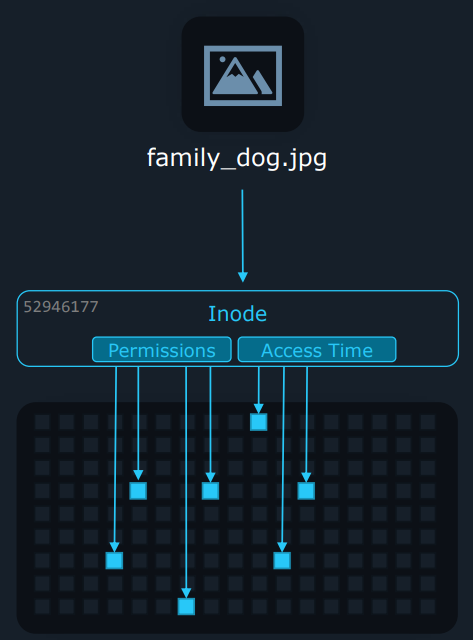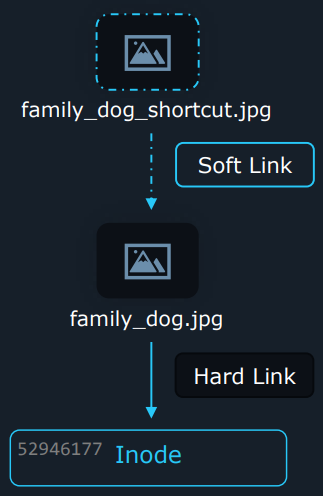understand and use essential tool
Command Line Basics
Login methods
- Local text-mode console: Log in directly on the computer using a text-based interface
- Local graphical-mode console: Log in directly on the computer using a graphical interface, like a desktop
- Remote text-mode login: Log in to a remote computer over a network using a text-based interface (e.g., via SSH or Telnet)
- Remote graphical-mode login: Log in to a remote computer with a graphical desktop
Old terms
- Console: The physical or main interface for interacting with a computer
- Virtual terminal: A software-based text interface, like a command-line window
- Terminal emulator: A program that mimics a text-based console on your screen
SSH
- Computer (SSH Client) → Server (SSH daemon)
ssh [email protected]
---
[email protected]'s password:
Logging in and Switching Users
Security features
- Access controls: Defines who access resources and what they can do
- PAM (Pluggable Authentication Modules): Handles authentication, authorization, and session management
- Network security: Protects systems from network-based threats
- SSH hardening: Secures the secure shell service for remote access
- SELinux: Enforces stricter security policies
- Others
Account types
| Account Type | Purpose | Examples | Attributes | Typical UID Range |
|---|---|---|---|---|
| User Account | Standard accounts for interactive login by humans | bob, michael, dave | Username, Password (stored securely), User ID (UID), Group ID (GID), Home Directory, Login Shell | Often starts at 1000 (>= 1000) |
| Superuser Account | Full administrative access to the system | root | Username: root, UID: always 0 | UID is 0 |
| System Account | Used by system services or daemons running in the background | sshd, mail, daemon | Username, User ID (UID), Group ID (GID), Home Directory, typically no login capabilities | Reserved range, often below 1000 |
| Service Account | Dedicated accounts for specific applications or services to run under | nginx, postgres | Username, User ID (UID), Group ID (GID), Home Directory, service-specific permissions | Often within system account range or user range |
Groups
- A collection of users, primarily used to manage permissions efficiently. Users can belong to multiple groups
Essential commands
- User
# Display user account database
cat /etc/passwd
---
root:*:0:0:System Administrator:/var/root:/bin/sh
daemon:*:1:1:System Services:/var/root:/usr/bin/false
# Display user and group identity
id kyphan
---
uid=1001(kyphan) gid=1001(kyphan) groups=1001(kyphan),27(sudo)
# Display currently logged-in users
who
---
kyphan tty1 2025-04-16 09:30
kyphan pts/0 2025-04-16 10:15 (192.168.1.10)
# Display history of last logged-in users
last
---
kyphan pts/0 192.168.1.10 Wed Apr 16 10:15 still logged in
kyphan tty1 Wed Apr 16 09:30 still logged in
reboot system boot 5.15.0-generic Wed Apr 16 09:25 - 10:30 (01:05)
# Search for information and home directory
grep -i kyphan /etc/passwd
---
kyphan:x:1001:1001::/home/kyphan:/bin/bash
- Group
# Display group database
cat /etc/group
---
root:x:0:
sudo:x:27:kyphan
kyphan:x:1001:
Switch users
su- Switches to another user account. If no user is specified, it defaults to root
- Requires the target user's password with
su - - Directly using su to become root for extended periods or sharing the root password is often discouraged for security reasons
# Switch to the root user
su -
---
Password:
# Execute a single command as root
su -c "whoami"
---
Password:
root
sudo- Allows permitted users to execute specific commands as another user (typically root) without needing the target user's password
- It requires the user's own password for authentication
- Provides better accountability and allows granting specific, limited administrative privileges instead of full root access
# Execute a command with root privileges
sudo apt-get update
---
[sudo] password for kyphan:
# Display the sudoers configuration file
cat /etc/sudoers
---
root ALL=(ALL:ALL) ALL
%admin ALL=(ALL) ALL
%sudo ALL=(ALL:ALL) ALL
- no-login shell
- Assigns a shell like
/sbin/login,/usr/sbin/nologin, or/bin/falseto an account (often system accounts or even root on hardened systems) prevents users from logging in directly using that account - Enhances security by forcing administrative tasks through mechanisms like sudo or requiring a switch from a standard user account
- Assigns a shell like
# Check the login shell for the root user
grep '^root:' /etc/passwd
---
root:x:0:0:root:/root:/bin/bash
Using System Documentation
Commands
--help: Displays a brief summary of their usage and options
ls --help
# Pager
journalctl --help
man: Displays a comprehensive manual pages
man journalctl
man man
man 1 printf
man 3 printf
apropos: Searches the names and short descriptions of all manual pages for a specific keyword
apropos director
apropos -s 1,8 director
# Update the manual page index database
sudo mandb
Additional System Documentation
info: Accesses documentation in the GNU Info format
info bash
/usr/share/doc: Contains supplementary documentation provided by installed packages
cd /usr/share/doc/bash
less INTRO
grep "command" INTRO
Working With Files and Directories
List files and directories
ls: Lists the contents of a directory
ls
ls -a
ls -l /var/log
ls -lah
Filesystem tree
- Current working directory
- Relative path
- Absolute path
cd /var/log
cd -
cd ..
Create files
touch: Creates an empty file if it doesn't exist, or updates the access and modification timestamps of an existing file
touch /home/kyphan/text.txt
Create directories
mkdir
mkdir -p /home/kyphan/folder
Copy files and directories
cp: Copies files or entire directory structures
cp hello.text folder/
cp hello.txt folder/hello_copy.txt
# If hello does not exist, it copies only the contents, if not, it copies the entire folder/ to be hello/folder/
cp -r folder/ hello/
Move files
mv: Moves files/directories to a different location or renames them
mv abc.txt hello/
mv abc.txt abcd.txt
mv folder/ new_folder/
Delete files and directories
mv: Removes files and directories
rm abc.txt
rm -r folder
Working With Hard Links
Inodes
- An inode (index node) is a data structure on Unix-like filesystems
- Each file and directory on the filesystem has a unique inode
- It stores metadata about the file or directory, excluding the filename and the actual file content
- Key metadata includes file type, permissions, owner, file size, timestamps, link count, pointers, etc.
# Create the file and write text into it
echo "Picture of Milo the dog" > Pictures/family_dog.jpg
# Display detailed status information
stat Pictures/family_dog.jpg
---
File: Pictures/family_dog.jpg
Size: 49 Blocks: 8 IO Block: 4096 regular file
Device: fd00h/64768d Inode: 52946177 Links: 1
Access: (0640/-rw-r-----) Uid: ( 1000/ aaron) Gid: ( 1005/ family)
...
- How it works
- When accessing a path like Pictures/family_dog.jpg, the system locates the Pictures directory
- It searches the directory's contents for the entry family_dog.jpg
- This entry contains the corresponding inode number
- The system uses the inode number to find the inode structure itself
- From the inode, it reads metadata (like permissions) and gets the pointers to the data blocks to retrieve the file's content
- Relationship
- A directory entry links a filename to an inode number
- The inode stores metadata and points to the data blocks

Hard links
- A hard link is simply another directory entry (another filename, potentially in a different directory) that points to the exact same inode as the original file
- Benefit
- Allows multiple filenames to refer to the same file data without duplicating the data itself, thus saving storage space
- Instead of having two separate copies of a large file, you have two names pointing to one set of data blocks via the shared inode
# ln path_to_target_file path_to_link_file
# Recursively copy the contents of Aaron's Pictures directory to Jane's
cp –r /home/aaron/Pictures/ /home/jane/Pictures/
# Create a hard link: Jane's path now points to the same inode as Aaron's path
ln /home/aaron/Pictures/family_dog.jpg /home/jane/Pictures/family_dog.jpg
# Display detailed status information
stat Pictures/family_dog.jpg
---
File: Pictures/family_dog.jpg
Size: 49 Blocks: 8 IO Block: 4096 regular file
Device: fd00h/64768d Inode: 52946177 Links: 2
Access: (0640/-rw-r-----) Uid: ( 1000/ aaron) Gid: ( 1005/ family)
...
# The link count for inode 52946177 decreases from 2 to 1
rm /home/aaron/Pictures/family_dog.jpg
# The link count for inode 52946177 decreases from 1 to 0
rm /home/jane/Pictures/family_dog.jpg
- Data deletion
- The actual file data (disk blocks) associated with an inode is only marked for deletion (and eventually overwritten) when its link count reaches zero
- Removing a hard link (rm) just deletes that specific directory entry and decrements the inode's link count
Limitiations and considerations
- Only hardlink to files, not folders
- Only hardlink to files on the same filesystem
# Add existing user 'aaron' to the supplementary group 'family'
useradd -a -G family aaron
# Add existing user 'jane' to the supplementary group 'family'
useradd -a -G family jane
# Change file permissions: owner=read/write, group=read/write, others=none
chmod 660 /home/aaron/Pictures/family_dog.jpg
Working With Soft Links
Soft (symbolic) links
- Unlike a hard link which points directly to an inode, a symbolic link's content is simply the pathname (text string) of another file or directory (the target)
- It is used to create convenient access points, redirect paths, or link across different filesystems or partitions

# ln -s path_to_target_file path_to_link_file
# Create a symbolic link named 'family_dog_shortcut.jpg' and points to the absolute path '/home/aaron/Pictures/family_dog.jpg'
ln –s /home/aaron/Pictures/family_dog.jpg family_dog_shortcut.jpg
ls -l
---
lrwxrwxrwx. 1 aaron aaron family_dog_shortcut.jpg -> /home/aaron/Pictures..
readlink family_dog_shortcut.jpg
---
/home/aaron/Pictures/family_dog.jpg
echo "Test" >> fstab_shortcut
---
bash: fstab_shortcut: Permission denied
ls -l
---
lrwxrwxrwx. 1 aaron aaron family_dog_shortcut.jpg -> /home/aaron/Pictures..
ln –s Pictures/family_dog.jpg relative_picture_shortcut
- If the target file or directory is deleted, moved, or renamed, the symbolic link is not automatically updated or removed
- It continues to point to the original path, which now leads nowhere. Such links are called "broken" or "dangling" links - "No such file or directory" error
Limitiations and considerations
- Softlink to files and folders
- Softlink to files on different filesystem as well
List, Set, and Change Standard Ugo/RWX Permissions -- Continue
Lab
Logging in and System Documentation
man ssh | grep version
ssh -V
apropos hostname
hostnamectl
mandb
man ssh | grep verbose
ssh -v alex@localhost
ls -la /home/bob/data
ssh bob@dev-host01
touch myfile
apropos ssh
sudo mandb
apropos "NFS mounts"
touch nfsmount.conf
Files, Directories, Hard and Soft Links
mkdir -p /home/bob/lfcs
touch /home/bob/lfcs/lfcs.txt
cp -r /tmp/Invoice/ /home/bob/
cp -a /home/bob/myfile.txt /home/bob/data/
cp -r /home/bob/lfcs /home/bob/old-data
rm /home/bob/lfcs/lfcs.txt
mv /home/bob/lfcs/ /home/bob/new-data/
rm -rf /home/bob/lfcs
ln -s /tmp /home/bob/link_to_tmp
ln /opt/hlink /home/bob/hlink
mv /home/bob/new_file /home/bob/old_file
mkdir -p /tmp/1/2/3/4/5/6/7/8/9
ls --full-time